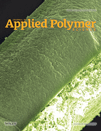Synthesis of functional poly(styrene)-block-(methyl methacrylate/methacrylic acid) by homogeneous reverse atom transfer radical polymerization: Spherical nanoparticles, thermal behavior, self-aggregation, and morphological properties
Abstract
This study investigates the use of homogeneous reverse atom transfer radical polymerization for the synthesis of polystyrene (PS) initiated by conventional radical peroxide with copper bromide in the lower oxidation state and a 2,2′-bypyridine complex as the catalyst. In a second stage, an amphiphilic block copolymer containing methyl methacrylate (MMA) was synthesized via normal atom transfer radical polymerization in two steps, followed by partial hydrolysis of the methyl ester linkage of the MMA block under acidic conditions. The block copolymer PS699-b-P(MMA232/MAA58) obtained had a narrow molecular weight dispersity (Ð < 1.3). The structure of the precursor, PS-b-PMMA, and resultant polymer, was characterized and verified by FTIR and 1H-NMR spectroscopy as well as size exclusion chromatography. The self-aggregation of PS699-b-P(MMA232/MAA58) in organic solvents was monitored by UV spectroscopy, whereas the morphology and size of the formed microaggregates were investigated by transmission electron microscopy and dynamic light scattering. The results indicate that this copolymer formed regular spherical reverse micelles with a core–shell structure. The atomic force micrographs of PS699-b-P(MMA232/MAA58) showed a rough surface morphology owing to microphase separation of the block copolymer. In addition, thermal characterization was performed by differential scanning calorimetry and thermogravimetric analysis. The glass transition temperature of PS699-b-P(MMA232/MAA58) decreased significantly (65°C), when compared to PS and PMMA, suggesting that an enhanced movement of the polymer chains resulted by the segregation of the hydrolyzed P(MMA232/MAA58) block. © 2013 Wiley Periodicals, Inc. J. Appl. Polym. Sci., 2013




